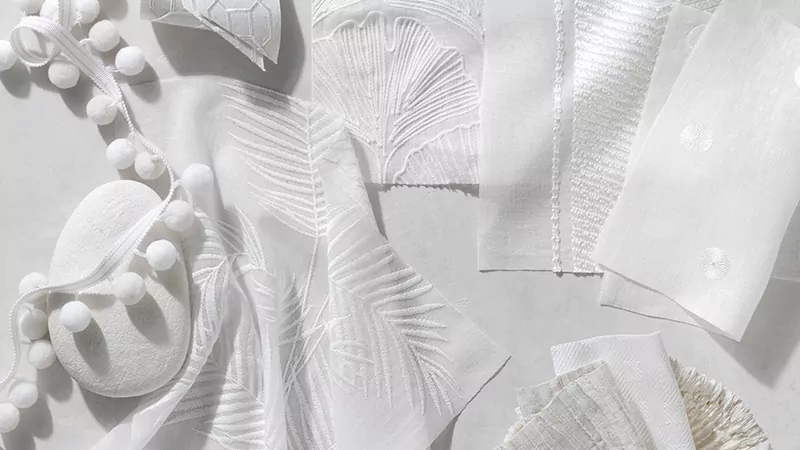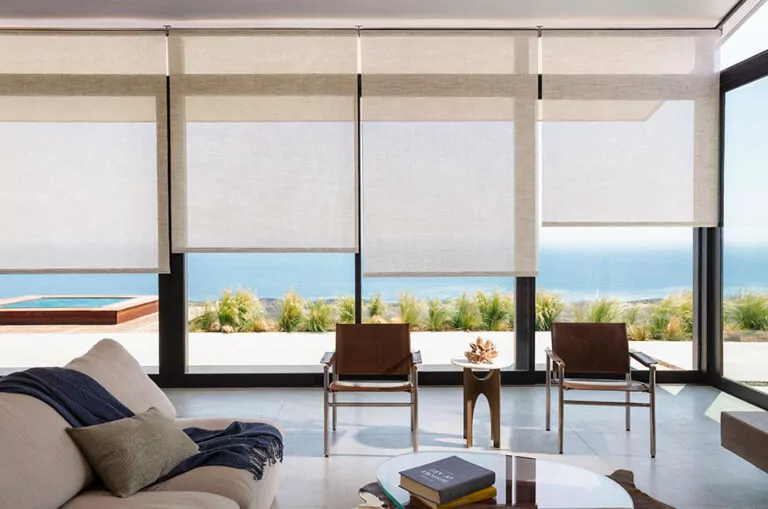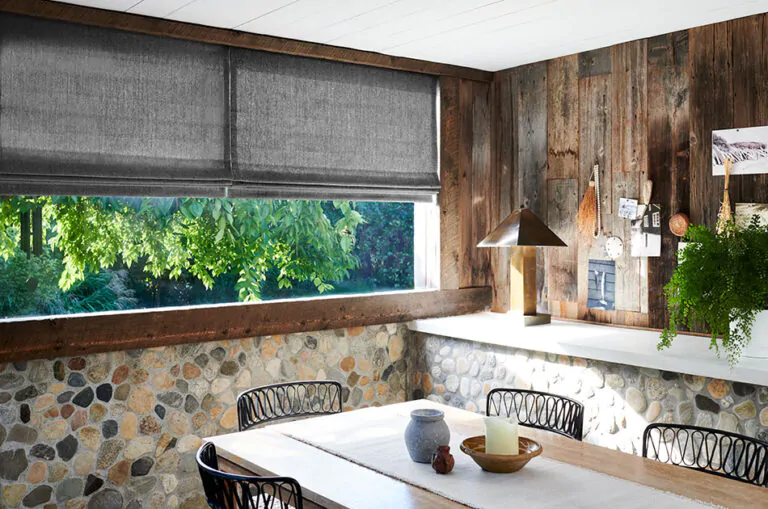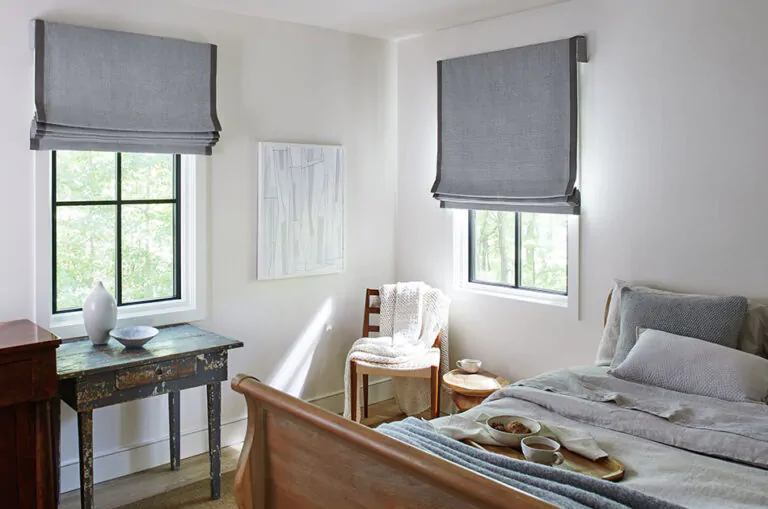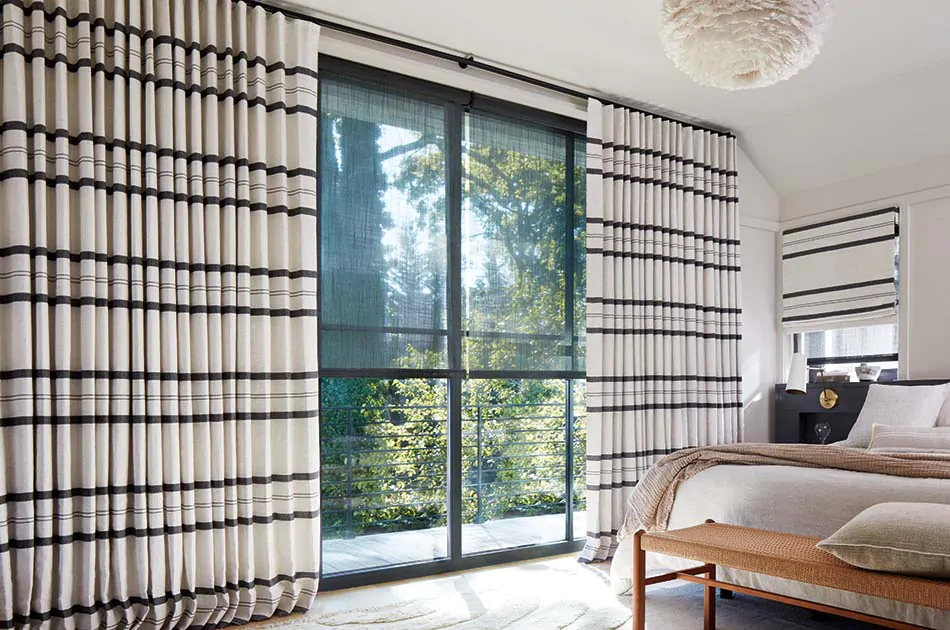
Light Filtering vs Blackout: How to Choose
Looking to understand the difference between light filtering vs blackout? These terms, when used for window treatments, refer to how much or how little light filters through the window treatment material, and the effect that light has on the room. Light filtering and blackout options are available for every type of window treatment, including shades, blinds and drapery. This means you can choose the right product — or combination — that best suits your aesthetic style and functional needs.
To learn how to choose between light filtering vs blackout shades, blinds or drapery, first learn what the two terms mean and the benefits of each. Then get more guidance about deciding between the two before diving into your product options.
Get a Full Window Covering Overview
Learn about all the main types of window coverings including Drapery, Shades and Blinds in our comprehensive guide. READ THE GUIDE
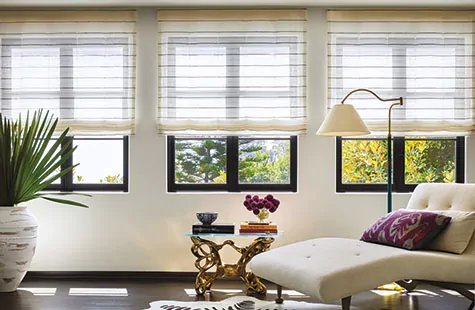
What Is Light Filtering?
Light filtering window treatments are those that allow some light to filter through when the window treatment covers your window. The effect is softened natural light with a reduced glare.
The amount of light allowed through depends on the opacity of the material, with some allowing more light through (like sheers) than others.
Benefits of Light Filtering Window Treatments
Why choose light filtering vs blackout window treatments? Light filtering materials offer several unique benefits, including:
- Softens natural light – Light filtering window treatments let natural light in while softening its intensity, for a gentle glow that creates a more inviting aesthetic for your space.
- Reduces glare – By softening natural light, light filtering window treatments also reduce the sharpness of glare on TV and monitor screens — and it prevents you from squinting.
- Blocks UV rays – As light is filtered through the window treatment, UV rays from the sun are also blocked which are the main cause of fading of your furniture and flooring.
FAQ: Can You See Through Light Filtering Shades at Night?
The privacy achieved from light filtering window treatments at night depends on the opacity of the material chosen. More transparent materials like sheers and many Solar Shades provide only a little privacy during the day and even less at night.
For better privacy at night, layer light filtering window treatments for greater coverage, or choose blackout window treatments that offer the very best coverage.
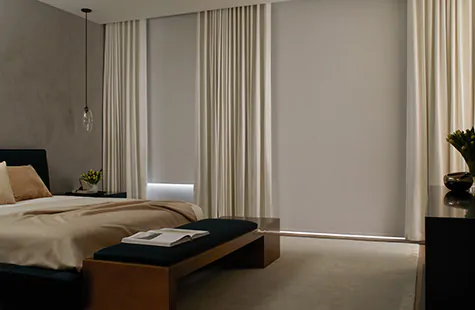
What Is Blackout?
Blackout refers to window treatment material that blocks up to 99% of the natural light entering the room. The result is a calming room darkening effect and the best privacy coverage, which best suits bedrooms and media rooms.
Benefits of Blackout Window Treatments
When deciding between light filtering vs blackout materials, consider these benefits unique to blackout materials:
- Blocks natural light to help you sleep – Blackout window treatments give you a room darkening effect that creates a calming atmosphere and can help you sleep better at night.
- Cuts glare – By blocking most of the natural light in the room, blackout materials completely cut glare, which is ideal for media rooms.
- Provides excellent privacy – Blocking light also means blocking the view — these types of window treatments give you the best coverage for excellent privacy.
FACTORS TO CONSIDER WHEN CHOOSING BETWEEN LIGHT FILTERING VS BLACKOUT
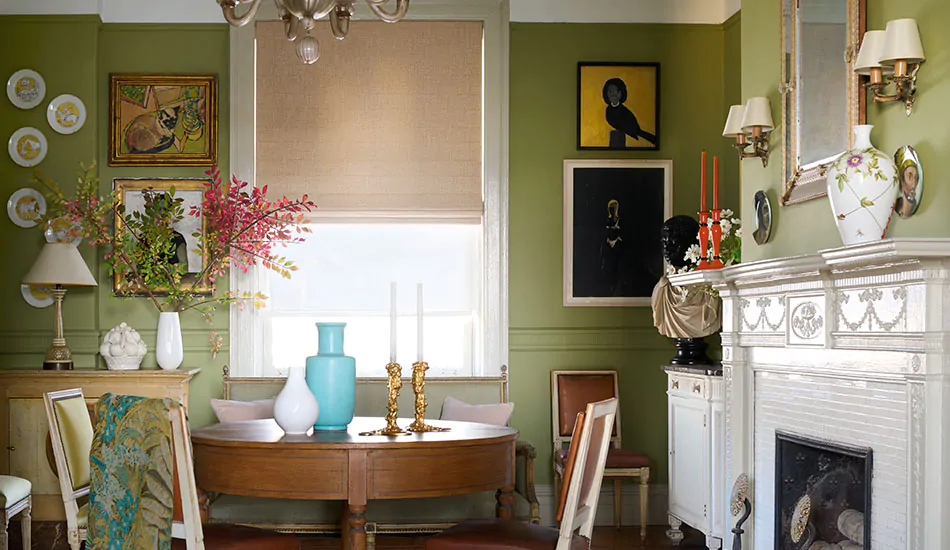
As you consider light filtering vs blackout shades, blinds or drapery, it’s important to think through these factors, which may affect your decision:
Room Function
How you use your room and how natural light affects what you do is a key consideration when deciding between light filtering vs blackout window treatments. For instance, in your bedroom, darkness and privacy will be key, but for your living room, you may enjoy the natural light during the day for reading or entertaining friends and family, and then require privacy at night.
When You Use the Room
Depending on what time of day you typically use the room, light filtering or blackout window treatments could be the better option. For rooms you’re likely to use in the morning, such as the kitchen or breakfast nook, light filtering window treatments can help soften the morning light for a peaceful, inviting space. Yet for rooms often used in the evening, like the dining room, blackout options can provide you with the privacy you need for your evening gatherings.
The Amount of Sun the Room Gets
If your room gets lots of natural sunlight, you’ll either want to embrace it or block it, depending on how you plan to use the room. For rooms where you want to optimize the beauty and warm glow of the sunlight while mitigating its damaging UV rays, go with light filtering window treatments. If you’d rather block that light, your best bet is blackout window treatments. For rooms without a lot of sunlight, you’ll likely want to optimize what little light you do have, in which case more transparent light filtering options, like sheers or Solar Shades, may be best.
Product Options for Light Filtering & Blackout Window Treatments
When it comes to deciding between light filtering vs blackout, luckily, your preferred product choice likely won’t limit you. All types of window treatments have both light filtering and blackout material options.
Explore each type of window treatment to compare your light filtering vs blackout shades, blinds and drapery to find the right fit for your home.
Light Filtering & Blackout Shades
When exploring light filtering vs blackout shades, you’ll find a wide variety of options, from sleek Roller Shades to elegant Roman Shades, and chic Cellular Shades. All types of Shades, except Solar Shades, come in both light filtering and blackout options.
Roller Shades and Cellular Shades are made with light filtering or blackout materials to achieve your desired light and privacy control.
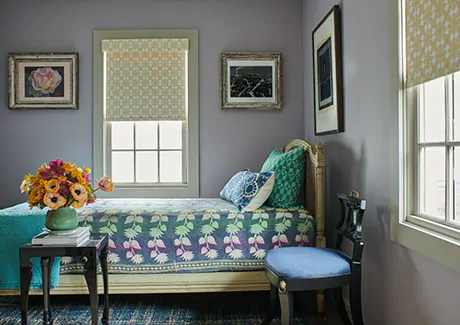
Roller Shades: Light Filtering & Blackout
Roller Shades are a simple, versatile window treatment option that feature a single panel of material that rolls around a tube at the top of your window.
From semi-transparent delicate options to opaque materials that block up to 99% of the natural light, Roller Shades come in an array of choices.
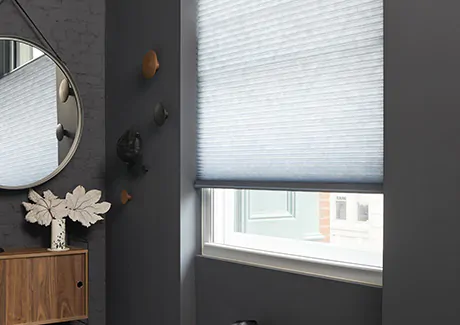
Cellular Shades: Light Filtering & Blackout
Cellular Shades feature a honeycomb design that provides excellent insulation against both hot and cold air, helping to regulate your interior temperatures.
Beyond just light filtering and blackout materials, you can also choose Day/Night Cellular Shades that combine a sheer and blackout material on one shade.
As a type of Roller Shade, Solar Shades only offer light filtering options. They are made with unique material that allows light to filter through, while blocking up to 99% of UV rays.
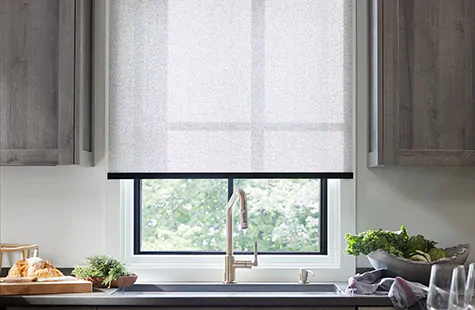
Solar Shades: Light Filtering Only
Solar Shades come in different transparency levels, from 1%, which blocks 99% of UV rays and is the least transparent to about 10%, which blocks 90% of UV rays and is more transparent so you can still enjoy your view.
When considering light filtering vs blackout options for Roman and Woven Wood Shades, these types of shades achieve varying degrees of light control with lining — or the absence of lining.
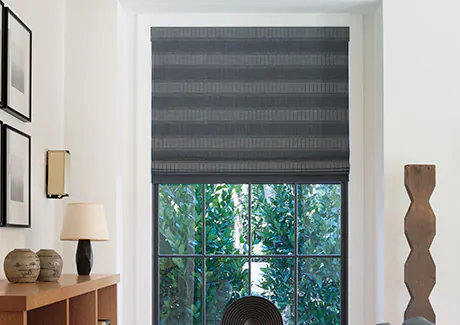
Roman Shades: Light Filtering & Blackout
Soft, tailored window treatments, Roman Shades fold into themselves when raised and unfold in a beautiful cascading motion when lowered.
For light filtering Roman Shades, choose an unlined shade or opt for privacy lining for a bit more coverage. To achieve a blackout look, opt for blackout lining.
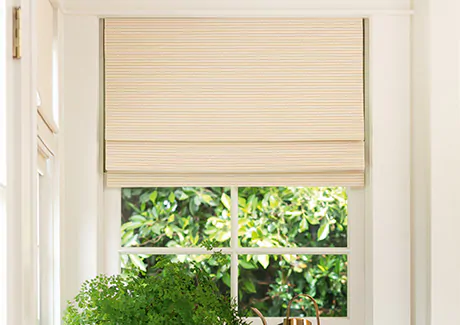
Woven Wood Shades: Light Filtering & Blackout
Made from woven natural fibers like bamboo, reeds and grasses, Woven Wood Shades come in folding styles like Roman Shades and one Roller Shade option.
Woven Wood Shades have the same three lining options as Roman Shades available for all styles except the Roller Shade style of woven shade.
Light Filtering & Blackout Drapery
Drapery comes in a variety of pleat styles to suit your preferences and all styles offer the same material and lining options so you can get just the right amount of light and privacy control. When comparing light filtering vs blackout drapery, you have three main options:
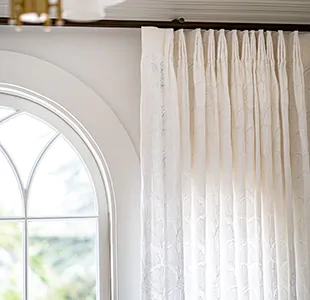
unlined
The amount of light unlined drapery will allow through will depend on the material chosen. Sheers, for instance, will let most light through while many wool blends will block more light and provide more coverage.
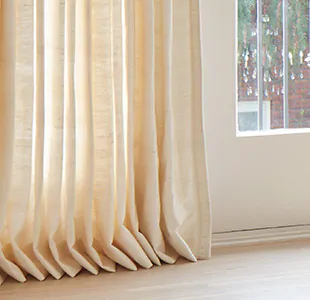
privacy lining
Drapery with privacy lining will allow some light through depending on the drapery material that’s been lined but will provide excellent privacy coverage for your peace of mind.
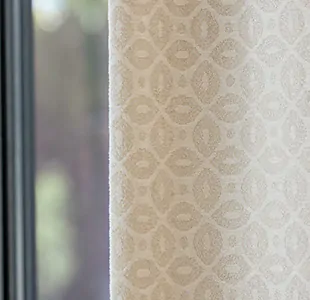
blackout lining
Blackout lining on any type of material of drapery will block up to 99% of the light coming through, delivering a room darkening effect and providing the very best privacy coverage.
Blinds: Light Filtering & Blackout
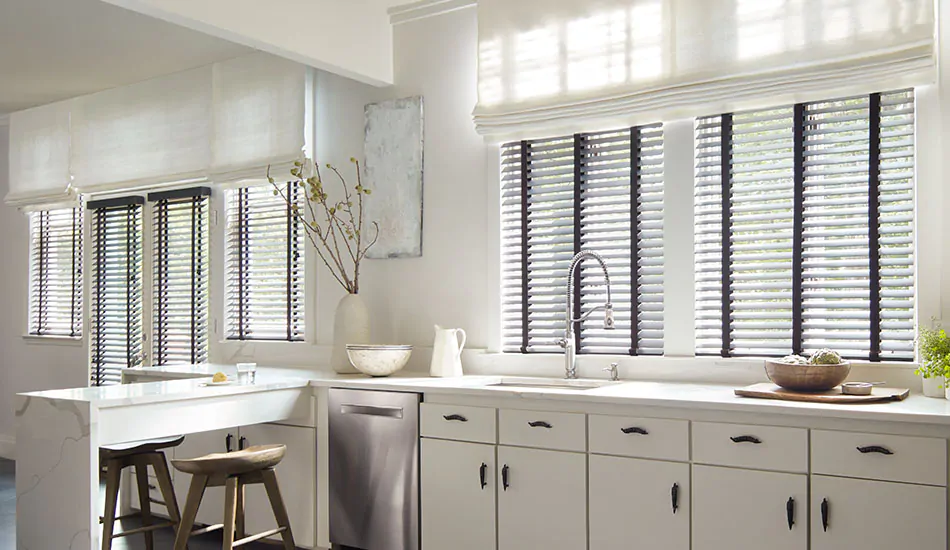
When it comes to comparing light filtering vs blackout Blinds, it’s important to consider that Blinds control light in a very different way to shades and drapery.
Blinds are not technically light filtering, since they’re made from hard, opaque material like wood, foam wood and metal. However, their tiltable slats do allow light to filter through to different degrees, depending on the angle of slats.
As for blackout Blinds, tilting the slats closed will provide a room darkening effect, although some light will be let through the small gaps made by the ladder cords that hold the slats together. For the best room darkening effect with just Blinds, consider adding decorative tape to the ladder cords for better coverage. Decorative tape is only available for Wood Blinds. Keep in mind adding tape is not compatible with cordless lift, so you’ll only be able to tilt the slats of your blinds with a wand or motorized tilt.
Vertical Blinds: Light Filtering Options
Vertical Blinds consist of vertical panels of material on a track system. These blinds come in several light filtering materials, many of which are the same used for light filtering Roller Shades and Solar Shades.
Compare Light Filtering vs Blackout Materials More Closely
Now that you understand the differences between light filtering vs blackout shades, blinds and drapery, you’re ready to explore your options more closely. Order free swatches of your favorite light filtering or blackout materials across product lines to determine which color and opacity is best for your space. Be sure to hold samples up to the light to get a sense for the light and privacy levels the window treatment will provide.
